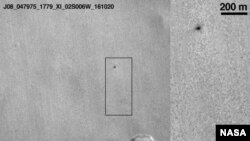The European Space Agency says it has found the crash site of its ill-fated Schiaparelli probe on the surface of Mars.
"I believe we have found where Schiaparelli landed,” said ExoMars Flight Operations Director Michel Denis. “This didn't land softly as we would have liked to, because the final phase of descent and landing did not function nominally.”
He added that many aspects of the descent went as planned, but that the parachutes were “released a bit too early” and the engines designed to help slow down the craft only fired for a few seconds, which, in his words was “also too little.”
“So basically Schiaparelli has reached the ground with a velocity which was much higher than it should, so several hundreds of kilometers per hour and is unfortunately then of course being, well, destroyed by the impact," he said.
Denis said the probe impacted the surface very close to its planned landing site, which allowed NASA’s Mars Reconnaissance Orbiter to take a picture of the crash site.
A roughly 15 meter by 40 meter dark patch is visible in the MRO photo. The impact site is about eight kilometers west of the planned touchdown spot near the equator at the Meridiani Plain.
“One can see clearly the parachute, which landed after it was released at the right place and the place where Schiaparelli should have landed softly but unfortunately did not land softly,” he said. “But one can see this clearly in the pictures."
ESA engineers continue to study the data to try to find the reason things went awry.
The probe was released from its mother ship, the Trace Gas Orbiter, Sunday, and over the ensuing days, it positioned itself for a landing. ESA lost radio contact with it about 50 seconds before it was scheduled to land.
As with any landing on such a distant body, it’s tricky, with some calling the descent “six minutes of hell,” as the craft plunges toward the red planet at 21,000 kilometers per hour.
The ExoMars program is a joint effort with Russia and seeks to determine if there is or was life on the Red Planet.











